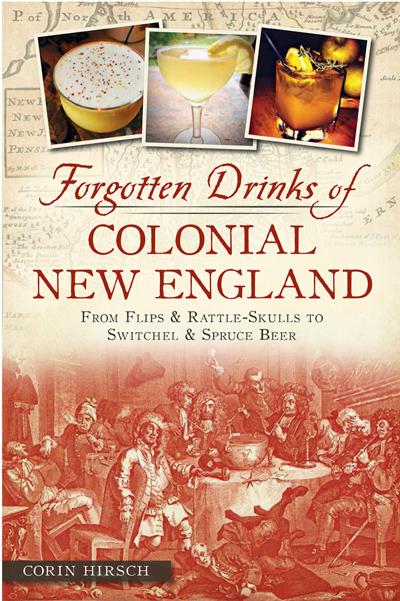"Forgotten Drinks of Colonial New England" by Corin Hirsch
 |
| "Forgotten Drinks of Colonial New England" |
People have enjoyed imbibing longer than history has been recorded. When the settlers came to America, they brought beer, cider, and rum to be enjoyed. Bowls of punch were served at meetings and balls. Taverns had a wide variety of drinks travelers and locals could sip and enjoy while reading the latest mail and newspapers.
The days of colonial America are fascinating to history buffs everywhere, but have you ever wondered about what was being served in the rooms where politics were being debated, and taxes weren't being paid? Corin Hirsch takes a peek at what was on the beverage menu in those days with her book "Forgotten Drinks of Colonial America". "Forgotten Drinks" combines the best of both worlds with its chronicling of American history and a list of alcoholic recipes for the history buff and beverage connoisseur.
Colonials Drank a Lot
Why did everyone, even children, have access to alcohol? That's explained in this book.
Hirsch's book begins with the shocking revelation that people during colonial times drank a lot of alcohol. She explains why they did and includes some anecdotes of people who overheard her conversations in local coffee shops who are shocked to hear a few details their teachers may have conveniently left out of their lessons. "My theory: Who wants to tell a room full of children that their great-great-great-times-ten-grandfather didn't pick up a hoe unless he was totted up with 'cyder' or that he may have had a liver the size of a grapefruit?" Hirsch matter-of-factly explains in her introduction why some true stories of everyday life may have been left out of textbooks. How do you explain why everyone, even children were allotted some measure of alcohol from breakfast time to bedtime?
Well, that explanation is mentioned in the pages of "Forgotten Drinks". Her research not only talks about local taverns and taprooms, but also mentions rum being a part of the Continental Army's daily ration to its soldiers. No matter the time of year, the time of day, or the occasion, there was a barrel that was easily accessible for anyone who was thirsty.
You don't have to Love History
"The typical colonial-era New Englander was young and poor, worked to the bone... and often tipsy. Hacking one's way through forests, worrying about native raids, eating tons of fish and preserved meat and spending every Sunday inside a freezing meetinghouse could help build an epic thirst." - "Forgotten Drinks of Colonial New England"
Even if you're not one for history, there is still plenty to enjoy in this book. There are some recipes left over from the colonial days that you will be sure to enjoy. My favorite recipes are the stone fence and the rattle skull. There are also modern takes to some of the 18th century recipes that can also be found in this book.
"Forgotten Drinks" has recipes and ideas for beverages to go with any meal at any time of the season. There are tipples for the end of the day after working in your yard, and there are beverages that helped keep you warm in the middle of a harsh New England winter. It's interesting to read this book with a colonial-era drink in your hand and relive the days when the fastest news travelled on horseback. Thrown some wood on the fire and pour yourself a flip. If you didn't like History class when you were in school, you'll find a new appreciation for it now.


Comments
Post a Comment